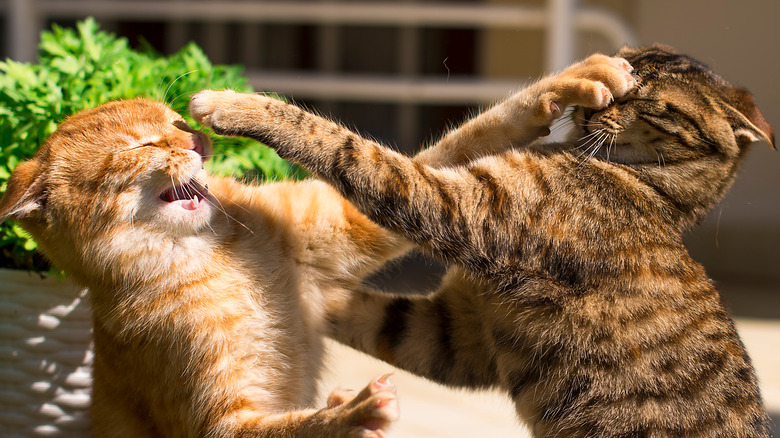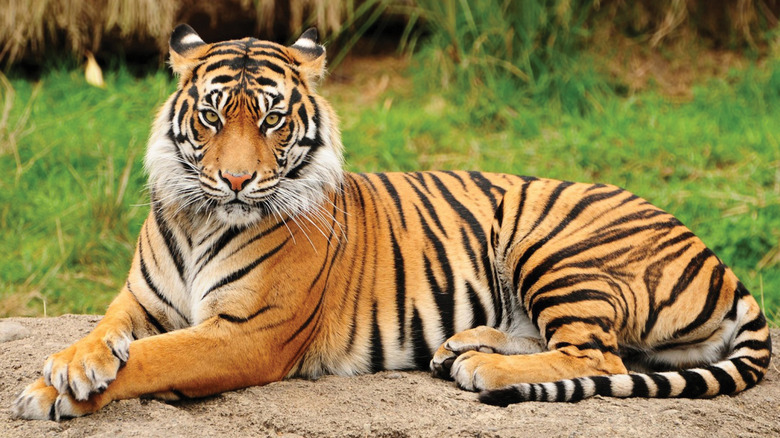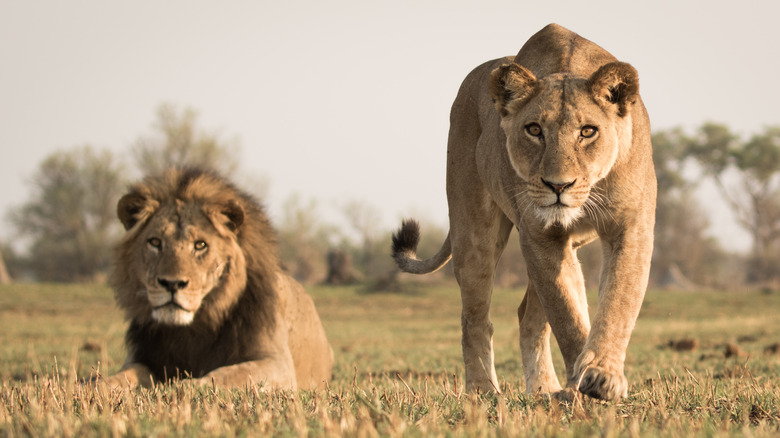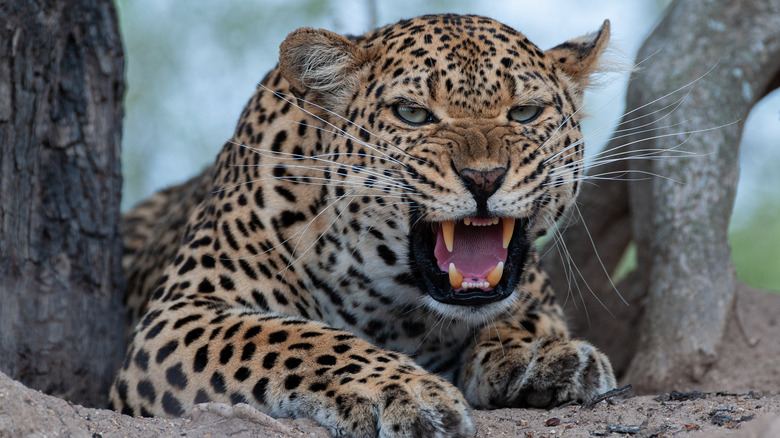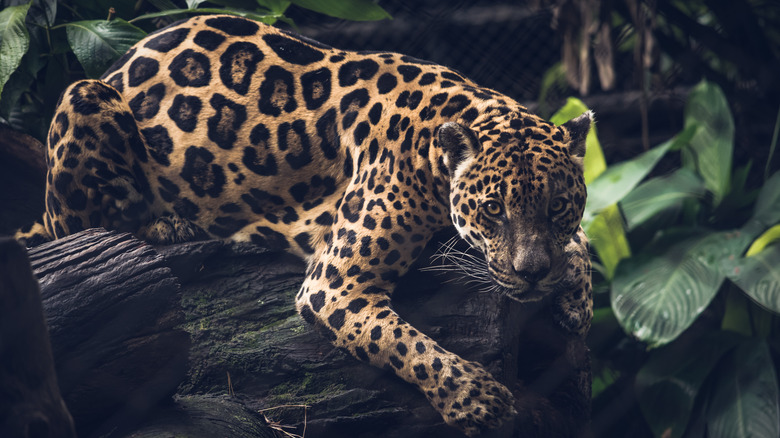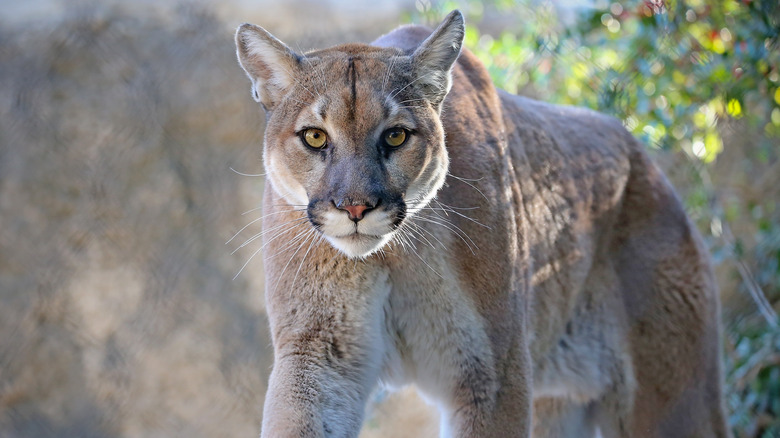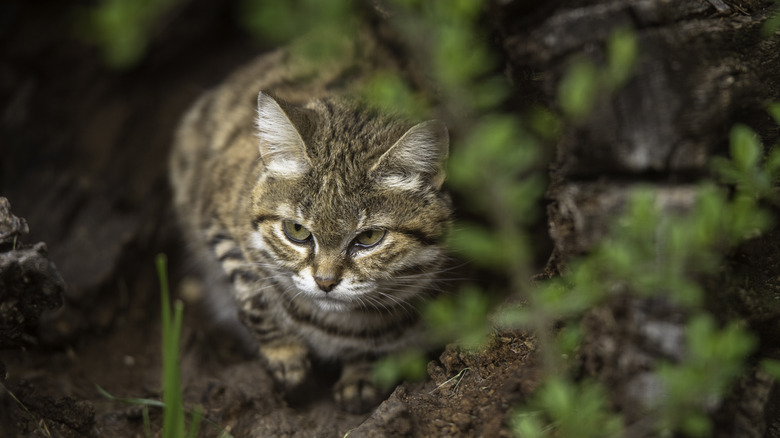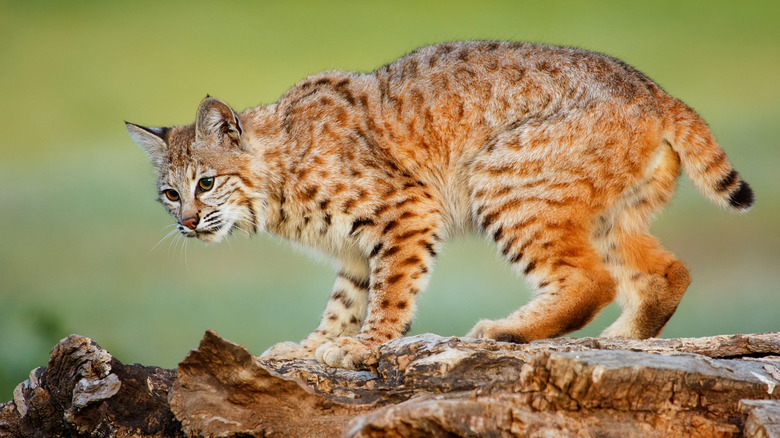Deadliest Cats In The World
Mr. Meowkins, deadly? It can't be! Well, don't worry. It's not. As much as dog people might wish it was true, house cats are not deadly, at least not in the traditional sense of the word. In fact according to Slate, there are exactly zero known incidents of pet cats deliberately killing their healthy, adult owners, though a few have been known to inflict a good mauling when provoked. Occasionally, you even hear about some poor dude who had to be airlifted to the hospital because he lost a knife fight with his pet cat. But so far, none of these incidents have left anyone in a coffin, with the exception of the cat. That we know of.
Of course, as with everything, it's all about definitions. What's not deadly to an adult could be deadly to an infant. And cats have been known to carry deadly diseases, too, so there's that. Plus, a cat that isn't deadly to a human could be Jack the Ripper to another species.
So, because it's fun to imagine Mr. Meowkins flying at your jugular with razor sharp claws outstretched, let's talk about deadly cats — all of them, from disease carrying stray house cats to Bengal tigers, in no particular order. And you might want to keep Mr. Meowkins in the laundry room tonight, because you never know.
It wasn't just Shere Khan who appreciated a nice man pie
If your criteria for "deadly" is just "how many people has this animal killed with its claws and teeth," then the Bengal tiger wins. Though to be fair, actual numbers are spotty and we're kind of just guessing. Historically speaking, though, tigers have killed an awful lot of people. According to WorldAtlas, colonial era records from the mid-1800s claim that tigers living in the Sundarbans area in the Bay of Bengal used to kill around 700 people a year. But remember that colonial record keepers also thought that Great Britain was ordained by God to rule the entire universe, so the accuracy of those records can probably be safely called into question.
The records from 100 years or so later attribute about 40 deaths annually to Sundarbans tigers, and data from the early '90s and 2000s has a number of around 50 a year. More recent data (from 2010 to 2017) shows a much lower rate of around seven a year, but that's not because tigers are becoming more well behaved, it's because there aren't as many tigers.
But let's also add to that the fact that even trained Bengal tigers are notoriously unpredictable and that some tigers from history have been prolific man eaters. In early 20th century India, for example, the Champawat Tiger is said to have killed about 100 people a year for four years. That's Champawat Tiger singular. So yeah, the Bengal tiger wins.
Moving from India to Africa will only slightly improve your odds
Cats are predators, and though you may love it (or not) when Mr. Meowkins leaves a dead rat on your doorstep, the truth is that the bigger the cat, the bigger the prey, and in the eyes of some cats you are the rat. According to a study published in the journal Nature, between 1990 and 2005 lions attacked and killed 563 people in Tanzania alone. Notably, there were considerably more lion-inflicted deaths than lion-inflicted injuries (that latter number was only 308), which means when lions attack people they do it because they mean it. Though to be fair, the numbers in the study were "more than 563" and "at least 308," so there is some wiggle room in that conclusion.
Lion attacks happen all over Africa, from rural areas to well-traveled safari routes. In 2015, a 29-year-old woman was killed when a female lion jumped through the window of her safari vehicle. The safari guide tried to fend the animal off, but the woman suffered catastrophic injuries and died at the scene.
Humans become targets for lions for the reasons you might think — because we're comparatively small and fleshy, we don't run very fast, and we don't have teeth, claws, or hooves to fight back with. Experts think injured and elderly lions may be more likely to target humans because it's harder for them to successfully kill larger game animals.
Leopards are best viewed from a distance. Or on television.
Big cats can be deadly but it's important to remember that they're just acting on instinct. Us humans have a responsibility to stay out of their way, and also to not train them to do stupid things like star in photo shoots. Like Bengal tigers, wild leopards are a force to be reckoned with. According to the Guardian, leopards living in Sanjay Gandhi National Park in Mumbai, India, attacked 25 people in 2002, which doesn't seem that high until you consider that there aren't that many leopards living in the park. In 2018, officials counted 41, though it's probable there were more back in 2002.
Keep in mind, though, that the leopards in Mumbai exist on a diet that is about 40% dog. Before you get all sad about the fate of Fido, these are almost exclusively stray dogs, and stray dogs in Mumbai are practically a biblical plague. Over a 20-year period, they were responsible for about 420 human rabies deaths in the city, so leopards might be killing people, but they're also kind of saving them.
Trained leopards are another case entirely. Any time you train a leopard to be okay with humans you can virtually guarantee it's not actually going to be okay with humans. Such was the case of Troja, the leopard that mauled 36-year-old model Jessica Leidolph during a photo shoot in August of 2021. Leidolph survived, but she suffered gashes on her face and head.
Jaguars go for the head
Have you ever wondered why jaguars don't spend as much time on stage compared to tigers and lions? It's because jaguars are the Dexters of the animal kingdom, the go-for-the-jugular kind of merciless predator. Actually, if we're being real, jaguars are more of a crush the skull kind of predator.
Jaguars don't kill a ton of people compared to Bengal tigers. According to onEarth, there are occasional sporadic reports of jaguar attacks, but for the most part, these cats stay pretty clear of humans. Even in Brazil, where jaguars are common, there has been only one confirmed human death from a jaguar attack. When they do attack people, though, they tend to inflict horrible damage on their victims' heads, so it's a good thing jaguar attacks are rare.
Jaguars living in captivity, though, don't get to avoid humans, especially humans that jump into their zoo enclosures to take selfies. This happened in 2019 when a woman crossed a barrier at the Arizona Wildlife World Zoo and got mauled for her troubles. In July of 2021, a 21-year-old man was taunting the jaguars at Jacksonville Zoo and Gardens in Florida when he bravely stuck his arm in the enclosure and got clawed. Well, you know what they say — you can take the jaguar out of jungle but you can't make people any less stupid.
Mountain lions don't get along with joggers
In the United States, attacks by predators are vanishingly rare. Most of us live inside sturdy houses and apartments, so we don't get bothered by bears or wolves or other things that want to eat us. When we venture outside into the great outdoors, though, all bets are off. That's especially true if you're a jogger. For some reason, America's apex predator (not the one on two legs, the other one) likes to attack joggers and bikers, possibly because they are moving fast, and mountain lions instinctively see them as fleeing prey. Of the 20 known mountain lion fatalities (since 1890) reported by Southeastern Outdoors, three were jogging or biking and several more were hiking. Hikers and bikers have also suffered non-fatal attacks.
Mountain lions that aren't chasing people who are recreating in parks will often attack children, in fact, more than half the fatalities reported by Southeastern Outdoors were people under the age of 18.
Twenty fatalities over more than a century is still not a lot, though, and it might be comforting to know that you can survive a mountain lion attack and even save your kid in the process. In the summer of 2021, a Los Angeles mother saved her 5-year-old son from a mountain lion attack by punching the animal with her bare hands. Not recommended, but when a lion has your kid, you do what you gotta do.
The African black-footed cat is the world's cutest killer
The African black-footed cat is not a danger to people, or even to wildebeests, gazelle, or jackrabbits, but birds fear it and rats tell stories about it to their children to make them behave. According to Smithsonian, the African black-footed cat is officially the world's deadliest cat by prey count, it's just that its prey thankfully does not include us.
Black-footed cats are Africa's smallest cats, in fact at 2 ½ to 4 pounds, they are smaller than the average house cat by more than half. They are also really, really cute — they don't look much different from a long-haired domestic tabby cat, except they're small so there's that extra "aw" factor. But alas, a black-footed cat isn't going to jump on your lap and make biscuits, because that's not how it rolls. A single black-footed cat can dispatch between 10 and 14 rodents or birds in a single night, and they have a kill success rate of about 60%, which is about three times the success rate of a typical lion. Sorry, so-called "king of the beasts."
What could a single cat possibly want with all those dead rodents and birds? Well, they usually put their heads on spikes as a warning to all the other rodents and birds. Just kidding. The black-footed cat has an extra-fast metabolism, so it literally needs to be constantly hunting and eating just to keep its adorable little body going.
Bobcats can be deadly ... for chickens
Pretty much everything wants to eat chickens. Foxes, raccoons, hawks, weasels, and of course humans, only humans are notably different because we'd rather not share our chickens with other predators.
Bobcats are an especially vicious chicken killer. According to the Merritt Herald and, like, every chicken forum on the internet, bobcats aren't always satisfied with killing just one chicken. Single bobcats have been known to take out entire flocks. In 2013, the Merritt Herald reported that a single bobcat killed 23 chickens in one go, mostly by biting them savagely in the heads or breaking their necks. The chickens' owners were pretty gracious considering what they'd lost — the bobcat was captured and later released elsewhere, you know, so it could kill someone else's chickens.
If you're remembering that 2021 viral video featuring a man fending off a bobcat with his bare hands and wondering why there's been no mention of bobcats being dangerous to humans, it's because they're generally not. They may attack a person they perceive as a threat to themselves or their young, but most bobcats that attack humans are rabid. That's kind of bad enough, though, so it's important to be aware that any wild animal — bobcats included — that act weird, stagger, foam at the mouth, or seem unafraid of you are potentially rabid. Physical contact with a rabid animal requires a trip to the hospital and a series of rabies vaccines, because rabies is 100% fatal.
Big cats without other options
We tend to think of predators as being kind of indiscriminate. They eat deer, they eat goats, whatever's easy. And it's certainly true that a big cat will kill livestock, which makes it pretty deadly as far as the livestock and the rancher are concerned. On the other hand, a recent study published in Biological Conservation looked at the number of livestock attacks perpetrated by big cats and what might be happening in the big cats' territory when they start killing livestock in large numbers, and found that it's not as simple as "whatever's easy."
The researchers found that big cats actually prefer to hunt wild game, even when there is plenty of livestock in the area. This does feel kind of counterintuitive, since it seems like a pygmy goat or a fat cow would be much easier prey than a deer or an antelope. But data seems to suggest that when there's less than 1,800 pounds of potential meat running around per square half-mile or so, big cats may start hunting cattle — but not so much before that. Cattle are obvious targets because they've got a lot of meat on them, so it's more reward for the effort. But when game animals become even more scarce — less than 1,200 pounds per half mile — big cats will also kill smaller livestock like sheep and goats.
So as far as livestock are concerned, big cats are deadly, but only when they don't have any other options.
When Mr. Meowkins refuses his rabies shot
We're safe from Mr. Meowkins though. Right? Well, mostly. Mr. Meowkins isn't super likely to scratch you to death while you sleep or put ricin in your morning coffee, even though he totally gives you that creepy look all the time and you're pretty sure he would if he could. But house cats can be deadly in other ways, in much the same way that bobcats can be deadly to humans — because they are potential vectors for the rabies virus.
According to the CDC, in America there are around 250 reported cases of rabies in cats each and every year, nearly four times as many as there are in dogs. That might seem surprising until you think about how cats living outdoors are always hunting solo and are thus more likely to encounter rabid wildlife than the average usually supervised dog. In fact, almost every case of a rabid cat recorded in the United States is an unvaccinated animal that got the disease from a bat, a raccoon, or some other wild animal. Stray and feral cats are particularly at risk since they're almost universally unvaccinated and often live in groups.
To be fair, 250 rabid cats isn't a huge number against the 95.6 million cats that live in America, but it does highlight the importance of getting a rabies vaccine for your cat, especially if your cat is going to have full or partial access to the great outdoors.
When Mr. Meowkins sits on your baby
There's a lingering myth that cats can suck the breath out of infants. You can be very sure that this myth isn't true, mostly because Snopes says it isn't. This bizarre belief has old roots, though, dating back to at least 1607. In 1791, a coroner in Plymouth, Massachusetts ruled death by cat in the case of a deceased infant, and no one thought to say, "Hey wait a second, why would a cat want to suck the breath out of a baby anyway?"
There are also modern stories about cats killing babies, not by sucking breath but by curling up next to their faces and suffocating them. Some researchers have even suggested that baby-smothering might be a thing for cats, but it's not easy to confirm. In 2000, a 6-week-old boy appeared to have been murdered by the family cat — he was found in his crib with the cat laying on his face — but pathologists later said he'd died from sudden infant death syndrome (SIDS). On the other hand, SIDS is really just the conclusion that pathologists arrive at when they can't figure out why a child died, so it's not like death by cat is totally off the table.
Still, if house cats kill babies, it happens only slightly more often than when African black-footed cats kill wildebeests, so it's not like that alone should give you reason to fear Mr. Meowkins or slap a "deadly" label on him.
When Mr. Meowkins takes out half the neighborhood bird population
We've established that house cats aren't dangerous to humans, even the ones that pounce on ankles. They're probably not behind 99.9% of all SIDS deaths and though they can carry rabies, the disease can be easily prevented with a rabies vaccine. So sleep tight, because Mr. Meowkins isn't coming for you. On the other hand, he may be coming for every single bird in your neighborhood, so you really should keep him inside.
According to a study published in the journal Animal Conservation, house cats are lethal killers. A single cat can kill four to 10 times as much prey as a similarly sized wild predator. That equals between 14 and 39 animals per 100 acres. Victims aren't always the animals we want them to kill, either, like house mice. They also take substantial numbers of beneficial animals like birds and lizards.
The numbers are a lot worse for feral cats, who don't get a bowl of Friskies every morning to help curb their appetites. Australian biologists estimate that one Australian feral cat can kill about 740 animals a year. Urban cats aren't innocent, either — in Australia they're thought to kill roughly 75 native animals per year, only because their density is a lot higher, this actually amounts to more kills per square mile than feral cats. When the dust clears, the total death toll for cat-related murders in Australia is about 1.5 billion animals a year.
